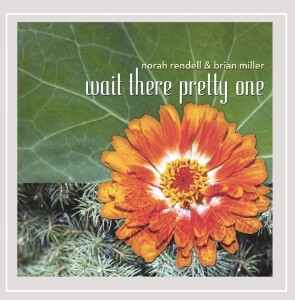 Put together these two experienced and talented musicians from the folk world, and you get, as you would expect, something above average in terms of performance and taste. Norah Rendell, originally from Vancouver, Canada, toured extensively as the dark princess of the flute and lead vocalist with the band The Outside Track before moving to Ireland to study flute and singing at the Irish Academy of Music and Dance, where she received an MA in Irish Traditional music. She is currently performing with the Doon Ceilidh Band, and it was here she met American guitarist Brian Miller, who also performs in the duo 5 Mile Chase.
Put together these two experienced and talented musicians from the folk world, and you get, as you would expect, something above average in terms of performance and taste. Norah Rendell, originally from Vancouver, Canada, toured extensively as the dark princess of the flute and lead vocalist with the band The Outside Track before moving to Ireland to study flute and singing at the Irish Academy of Music and Dance, where she received an MA in Irish Traditional music. She is currently performing with the Doon Ceilidh Band, and it was here she met American guitarist Brian Miller, who also performs in the duo 5 Mile Chase.
So with pedigrees such as this, you can imagine what you might expect to hear. Norah sings superbly and plays the flute like a diamond. The songs and instrumentals are neatly pinned by Brian on guitar, along with guest musicians like Stephani Custer and Nathan Gourley on fiddles — all the material is performed flawlessly.
The album opens with the traditional song “Alexander” teamed with “Paddy Fahy’s Jig.” This is followed by a set of reels “Jackson’s / Heathery Breese.” The third track is an interesting song written by Maria Dunn. It’s called “Heather Down Rd,” and is World War II story about the women who trained fighter pilots in Edmonton, Canada. It is, of course, a love story, as the women fall in love with the “Brylcream boys.” The album returns to more traditional material with songs “In the Town of Castle d’Oliver” and “The Cocks are Crowing” plus some jigs — “Grogan’s / Felix the Cat”– played on the flute.
At the seventh track, the album takes a twist with a traditional Quebecois song “Qui me Passerala le Bois.” If you don”t speak French, you will find a translation of the lyrics in the sleeve notes. A set of reels, “Dinny Delaney’s / Limestone Rock / Lad O’Beirnes” precedes the next song “An Greasai Brog” (the cobbler) set to the tune of “The Milk Market”and sung in Gaelic. Again a translation is included in the sleeve notes. After a set of some more jigs, the album returns to a more commercial sound with a nice cover of the Iris Dement song “Let The Mystery Be.” After a hornpipe and a reel, the album closes quietly with a traditional Scottish lullaby “Oh Can Ye Sew Cushions.”
I thought it was a very good album, although the flow did seem to wander a bit in the middle with the inclusion of a song in French and another in Gaelic. It led me to wonder who might enjoy the album the most. Not that it matters too much; my advice is just buy the album and enjoy the fine singing and musicianship of Norah and Brian.
(Two Tap, 2007)
